
Original Link: https://www.anandtech.com/show/6948/lenovo-thinkpad-x1-carbon-ultrabook-review
Lenovo ThinkPad X1 Carbon Ultrabook Review
by Dustin Sklavos on May 15, 2013 12:01 AM EST_678x452.jpg)
Introducing the Lenovo ThinkPad X1 Carbon
It shouldn't be surprising to know that AMD, NVIDIA, and Intel (especially Intel) will seed hardware amongst the tech reviewing industry. Most often it goes along with a product launch, but periodically it will be kit that they feel paints their product in a particularly good light. I don't think it's a secret that Ultrabooks and touchscreens have had a little bit of trouble getting off the ground. You could argue that the whole Ultrabook branding scheme, particularly after Intel expanded the definition, was more a way of renaming and redefining the notebook than anything. That it happens to be trademarked by Intel and thus AMD cannot have an Ultrabook is, I'm sure, just a coincidence.
.jpg)
We've had a lot of good Ultrabooks come through, mostly at the 13.3"-and-below scale. The problem the majority suffer from is a a simple one: Intel's initial definition of the Ultrabook basically aped the MacBook Air, and so that design language essentially became the order of the day. Ironically it was really only Dell and HP that had the audacity to tinker with the specs and color around the edges, but with the ThinkPad X1 Carbon, Lenovo has produced something that is unique. It's a 14" Ultrabook, but it hopefully heralds more of the kinds of designs we can look forward to in the 14" and up Ultrabook bracket.
| Lenovo ThinkPad X1 Carbon Specifications | |
| Processor |
Intel Core i5-3427U (2x1.8GHz + HTT, Turbo to 2.8GHz, 22nm, 3MB L3, 17W) |
| Chipset | Intel QS77 |
| Memory | 2x2GB integrated DDR3L-1333 |
| Graphics |
Intel HD 4000 Graphics (16 EUs, up to 1150MHz) |
| Display |
14" LED Glossy 16:9 1600x900 Touchscreen SHP5108 |
| Hard Drive(s) | 180GB Intel SATA 6Gbps SSD |
| Optical Drive | - |
| Networking |
Intel Centrino Wireless-N 6205 802.11a/g/n 2x2 Bluetooth 4.0 |
| Audio |
Realtek ALC269 HD Audio Stereo speakers Combination mic/headphone jack |
| Battery | 4-Cell, 45Wh (integrated) |
| Front Side | - |
| Right Side |
SD card reader Mic/headphone combo jack Mini-DisplayPort USB 3.0 Kensington lock |
| Left Side |
AC adaptor Vent USB 2.0 Wi-Fi switch |
| Back Side | - |
| Operating System | Windows 8 Pro 64-bit |
| Dimensions |
13.03" x 8.9" x 0.74" 331mm x 226mm x 20.85mm |
| Weight |
3.4 lbs 1.55kg |
| Extras |
720p Webcam SSD Bluetooth Backlit keyboard Intel vPro 10-finger touch Fingerprint reader |
| Warranty | 1-year depot/express warranty |
| Pricing |
Starts at $1,319 As configured: $1,556 |
I understand the enterprise sector often lags a little bit behind the consumer sector; new hotness typically needs to be proven reliable before it can get shipped to the more demanding business environment. For the most part the ThinkPad X1 Carbon is as modern as a notebook can be until Haswell arrives, but there are one or two oddballs.
The Intel Core i5-3427U is a respectable CPU and difficult to find fault with, sporting a healthy 1.8GHz nominal clock that typically bumps up to 2GHz under sustained load, yet Lenovo is stingy with the memory. If you want 8GB of memory, you have to buy their top end $1,759 model; it's not even an upgrade option on the lesser models, where you're stuck with 4GB of memory. 4GB of DDR3L-1333, not DDR3L-1600 like Lenovo's competitors are shipping. Thankfully, while Lenovo's site states the X1 Carbon is limited to one DIMM, the memory is operating in dual channel mode.
Given the X1 Carbon's enterprise aspirations, the SSD is Intel kit; the specific model number isn't readily available, but it supports SATA 6Gbps and features the odd 180GB capacity. Most of what's included with the X1 Carbon is as you expect, though the high resolution display is welcome. Note that while it's listed as being glossy, the glossy coating is actually a mild one; it's too glossy to really be called a true matte display, but it's not the nightmare of reflectivity that most glossy displays are.
Finally, thankfully, wireless connectivity includes 5GHz. It still baffles me how in 2013 anyone can ship a notebook without this.
In and Around the Lenovo ThinkPad X1 Carbon
People familiar with Lenovo's industrial design aren't going to be too terribly surprised with the ThinkPad X1 Carbon: black goes with everything. The body is built primarily out of carbon fiber, and the now oddly "traditional" ThinkPad chiclet keyboard is present, as is the trackpoint. Build quality all around is generally excellent; lid flex is minimal, body flex just plain doesn't exist, and there's precious little keyboard flex. Also, the dot on the "i" in ThinkPad on the lid glows red when the notebook is in use and strobes when it's asleep, so that's neat.
.jpg)
It's hard to find too much fault with the ThinkPad X1 Carbon taken on its own, but in a broader perspective and especially a historical perspective, the Lenovo acquisition of IBM's ThinkPad line still smarts. The X1 Carbon is further evidence of the consumerization of the ThinkPad line; the chiclet keyboard may be the best you can find, but it's still a chiclet keyboard. The touchpad has actually been replaced by a clickpad that has a wonderful surface but absolutely terrible clicking action and doesn't have dedicated buttons; thankfully, the trackpoint's dedicated buttons work just fine in a pinch.
.jpg)
That consumerization also betrays the X1 Carbon's loftier ambitions as an enterprise-class notebook. Those of you with good memories will remember a period of time where enterprise was all about ThinkPads and that was it, but are you noticing more HP EliteBooks and Dell Latitudes and Precisions running around than you used to? So it is with the X1 Carbon, where the 1-year default warranty, aforementioned chiclet keyboard, and complete lack of serviceability undermine the enterprise dream. Former models of the X1 also supported external slice batteries, but the X1 Carbon forces you to rely solely on its middling 45Wh battery, and that battery is not user-replaceable.
Keeping in mind that this review unit was sent to me by Intel, I'm keen to point out the curious way it highlights the odd dichotomy of Windows 8's user interface. This is a ten-point touch display, yet it's also 1600x900, and the notebook actually shipped to me with Stardock's Start8 installed, thus completely bypassing Modern UI. The traditional Windows desktop has always been absolutely dire for touch, only more so with a decently high dpi on the display, but it's vastly superior for productivity. In a way, the touchscreen in the X1 Carbon has been reduced to a sort of novelty.
Nearest I can tell, Intel added Start8, as it's not an immediately available option when configuring your own X1 Carbon. Keeping Windows 8 in mind, though, it's worth noting that you can't order the X1 Carbon with Windows 7 as an option unless you forego the touch display.
It must seem like I'm being too harsh on the ThinkPad X1 Carbon. Truth be told it's actually a very enjoyable Ultrabook to use; keyboard action is excellent, the 1600x900 display is attractive, and it's not too difficult to get used to using the mouse buttons above the clickpad. It's light, it's sturdy, and Intel's inclusion of Start8 is both the best and worst endorsement of Windows 8 on the planet. The problem is that despite the carbon fiber build and inclusion of vPro, this is not an enterprise Ultrabook. It's still priced like one, but it's not.
System Performance
By this point, Ivy Bridge is old hat. We have a fairly common ultra low voltage Intel Core i5 and a speedy Intel SSD; no dedicated graphics required. This isn't Lenovo's fault, it's just the result of catching a product this late in the refresh cycle. Performance testing winds up being more of a sanity check to make sure everything is running smoothly.
That said, I did run into a hiccup during testing. In BIOS, the CPU was set to "Battery Optimized," which locked it at 600MHz. The setting labeled "Maximum Performance" actually just allows the CPU to turbo the way it's been designed to, and I feel it's worth pointing out that the "Battery Optimized" mode actually had worse running time than "Maximum Performance." This is easy enough to explain; modern processors are designed to finish tasks and go idle as soon as possible, so capping the CPU's top speed prevents it from doing exactly that and forces it to work longer.
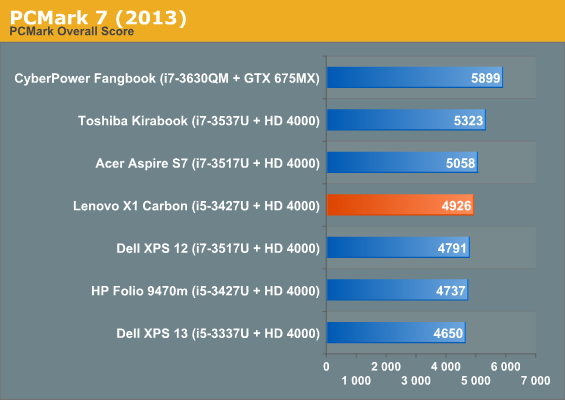
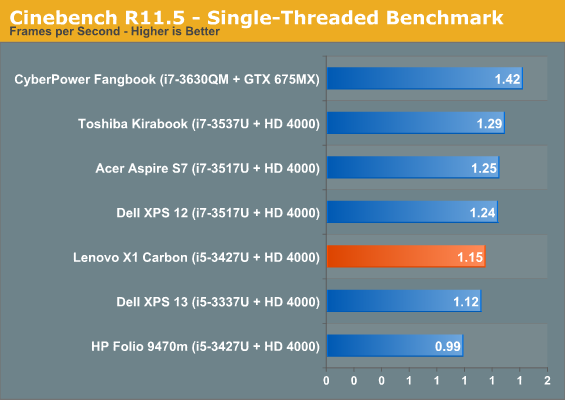

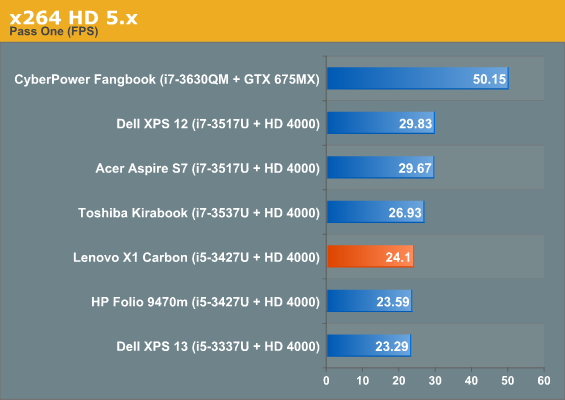
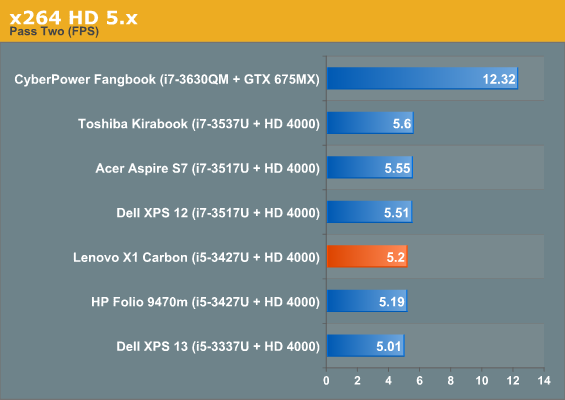
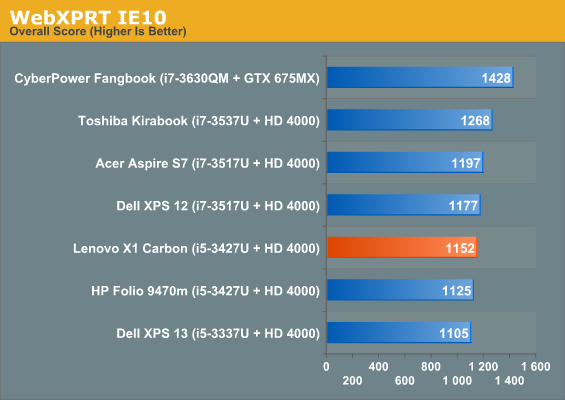
System and CPU testing yields absolutely no surprises; the ThinkPad X1 Carbon's i5-3427U falls in line exactly where it's supposed to.
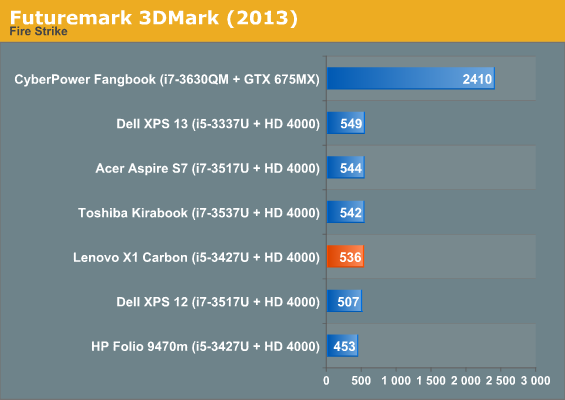

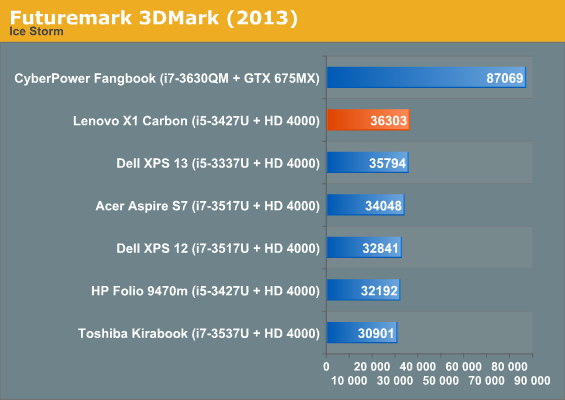
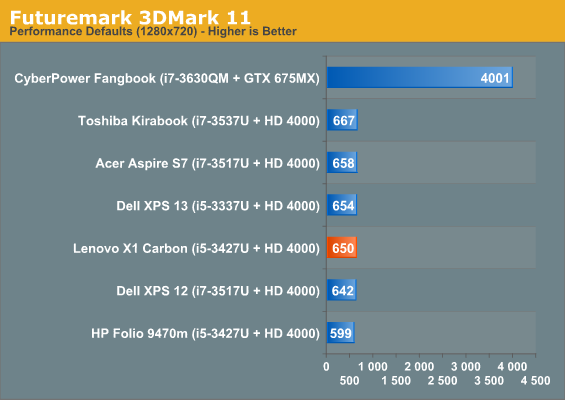
Graphics results are more of the same. The HD 4000 in the X1 Carbon puts in a strong showing (comparatively) in 3DMark's Ice Storm test, but it's basically still an Ivy Bridge HD 4000.
Display Quality
I don't know about the rest of you, but I'm pretty happy to be getting notebooks in for review that don't have lousy 1366x768 panels. I desperately want to believe this is the direction the notebook market is heading in, though a pair of $1,500+ notebooks don't really constitute a trend, and I'll be a lot happier when $600 notebooks have gotten past 1366x768.
The Lenovo ThinkPad X1 Carbon employs a 14" 1600x900 display standard; Lenovo lists it as "wide viewing angle" but it's still most definitely a TN panel. That said, viewing angles are definitely good, and it exhibits none of the "no sweet spot" issues that plague lower quality displays. Lenovo's pseudo-glossy finish isn't as brilliant as typical glossy finishes are, but it's also not as reflective.
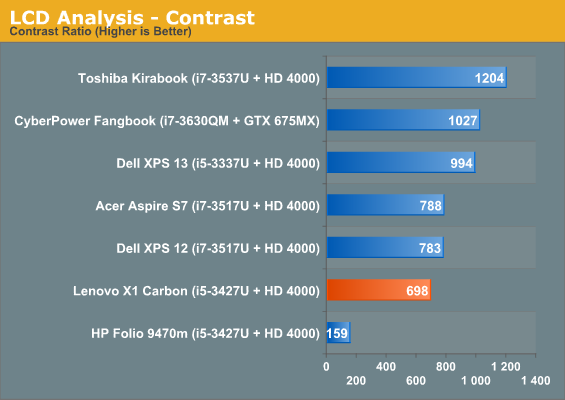
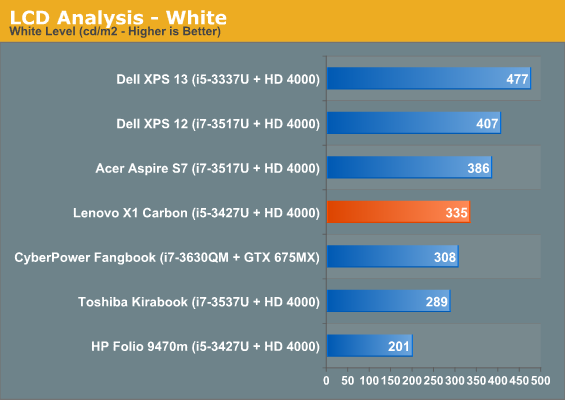

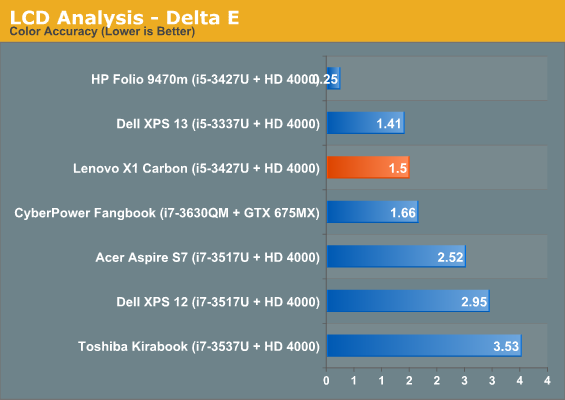
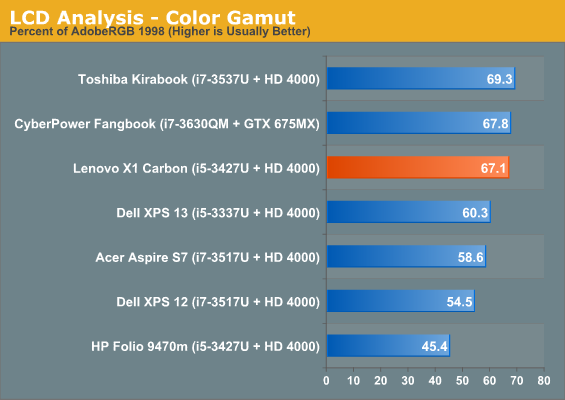
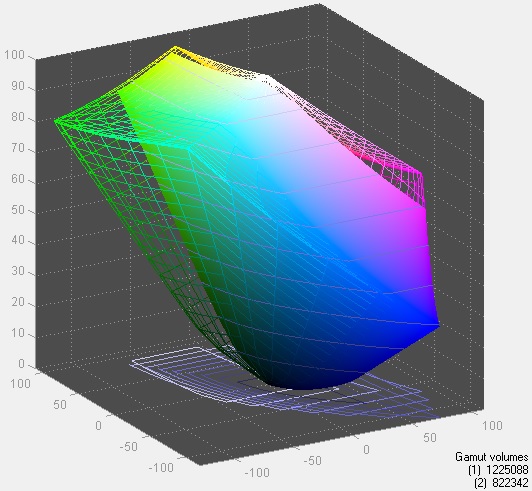
The X1 Carbon's display quality is acceptable, but take a look at the contrast graph to get a really good idea of how much of a difference spending just a little more on a display can make. The HP Folio's display has such horrible black levels that its contrast ratio is actually lower than its maximum brightness. Meanwhile, the X1 Carbon has a display that's both lovely and functional, and 1600x900 is about right for a 14" panel before you get into having to mess with the broken dpi settings in Windows.
Battery Life
While most of the Lenovo ThinkPad X1 Carbon's user experience is at least solid, battery life is one area where it falls horribly short. That Lenovo doesn't offer any extended battery option of any kind turns out to be a major problem.
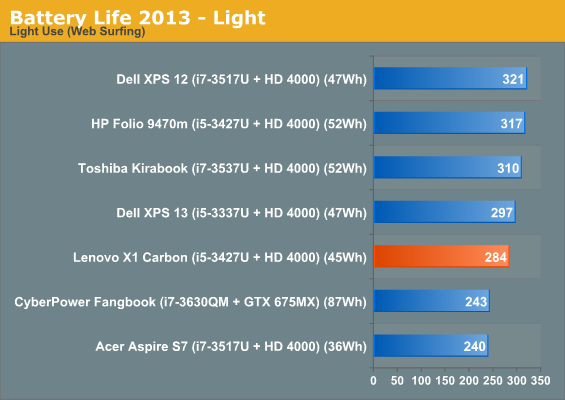
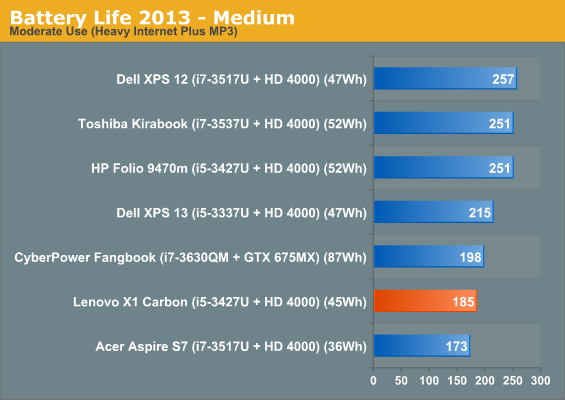
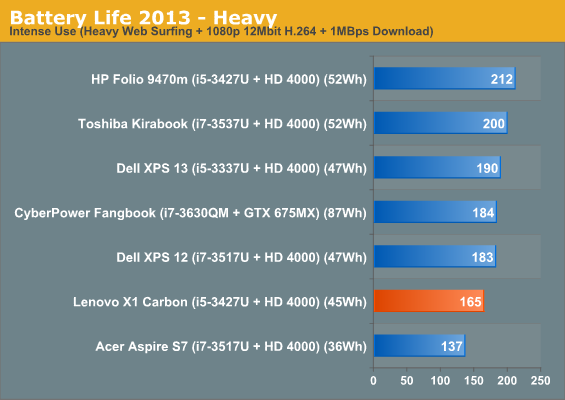
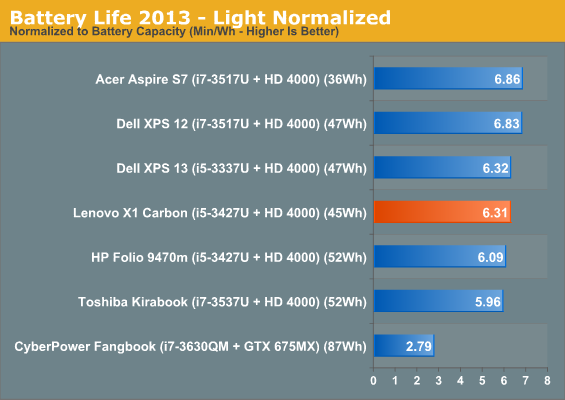

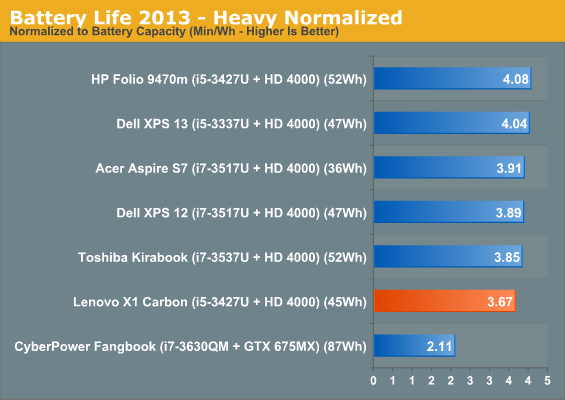
The X1 Carbon's battery life isn't horrible, but it's way out on the bottom end of competitive. Dell's two "prosumer" XPS notebooks both offer superior efficiency and running time, and the XPS 13 in particular can offer you a stellar 1080p IPS display in the process.
Heat and Noise
Sporting a larger chassis than most Ultrabooks, the Lenovo ThinkPad X1 Carbon is able to do a fantastic job of keeping the ultra low voltage Core i5 running cool. There's definitely a high-pitched whine to the fan when it spins up, but it's not especially loud under extreme, sustained load.
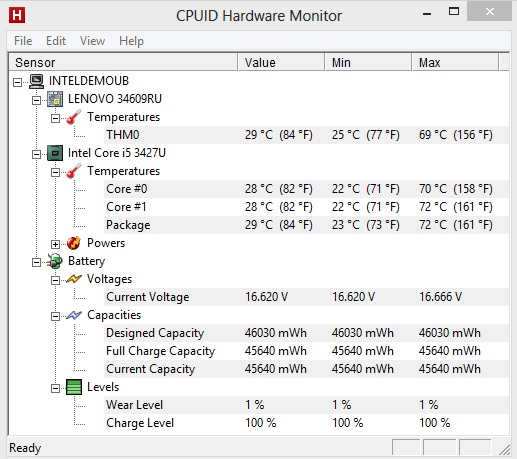
Thermally the X1 Carbon is almost boxing under its weight. None of the surfaces of the chassis get hot, and it's actually difficult to get either core of the i5 to break 70C. I think you could probably make a case for using a higher powered CPU in the Carbon's chassis, but I'm honestly happy just to see a notebook that not only doesn't have heat issues, it doesn't even flirt with them.
Conclusion: Prosumer Grade
Much as Mark Rosewater can't go a month without mentioning how he used to write for "Roseanne," I have a hard time not mentioning my background in video production. The reason to bring it up with the Lenovo ThinkPad X1 Carbon is simple: whether you're a hobbyist or a professional in any kind of content creation field, you have a pretty good idea of what "prosumer" means. Consumer grade hardware and software are generally (but not always) not worth your time, but professional grade kit often requires a substantial investment. Thus there's the middle ground: prosumer. Prosumer kit is typically fully featured, but doesn't cost an arm and a leg. You get 90% of the power of professional grade stuff at a fraction of the cost.
That's essentially what the Lenovo ThinkPad X1 Carbon is. Weird as it sounds, the ThinkPad is basically the Windows user equivalent of a Mac and has been for a while. The name has a cachet to it, and you have a good idea of what it represents. In the case of the X1 Carbon, we get a strong and sturdy build, great quality display, and the best chiclet keyboard in the business. We also get the kind of price premium we've come to expect for the ThinkPad brand, a premium that predates Lenovo's ownership.
.jpg)
I have often said that you cannot charge Apple prices for Dell products. That's not necessarily to disparage Dell, but merely to make a point: you can't make bargain consumer grade hardware and still try to sell it at a premium. The ThinkPad X1 Carbon is a fine Ultrabook, and the $1,187 touch-free entry level model is without question the best deal in the lineup (though the 4GB of DDR3 stings mightily) and easy to recommend. If you want 8GB of memory you'll have to fork over at least $200 more (you get a CPU upgrade in the process), which is a bitter pill to swallow.
Where the Carbon runs into trouble is that its price is, like its battery life, barely competitive, and the higher-priced models are almost impossible to justify. Actual business-class kit is more expensive, but the Carbon is really competing with the likes of Dell's XPS 13. Dell will sell you an XPS 13 with a 1080p IPS display, faster processor, and 8GB of memory for $1,299. Married to the 14" form factor? Not a problem, they'll give you an XPS 14 with the same resolution display for $999, and at $1,199 you can even get dedicated graphics hardware.
Ultimately, if you're still smarting from what Lenovo has done with the ThinkPad brand like I am, it can be difficult to appreciate the X1 Carbon. It bears repeating this really is an excellent Ultrabook, falling short primarily in battery life and price but otherwise pretty tough to argue with. And Lenovo has been thriving compared to some of the competition, so they must be doing something right. I just don't like how they've sacrificed the ThinkPad brand on the altar of consumerism, and the X1 Carbon doesn't buck the trend. It's a fantastic Ultrabook, but it's not enterprise.

_thumb.jpg)
_thumb.jpg)
_thumb.jpg)
_thumb.jpg)
_thumb.jpg)
_thumb.jpg)






